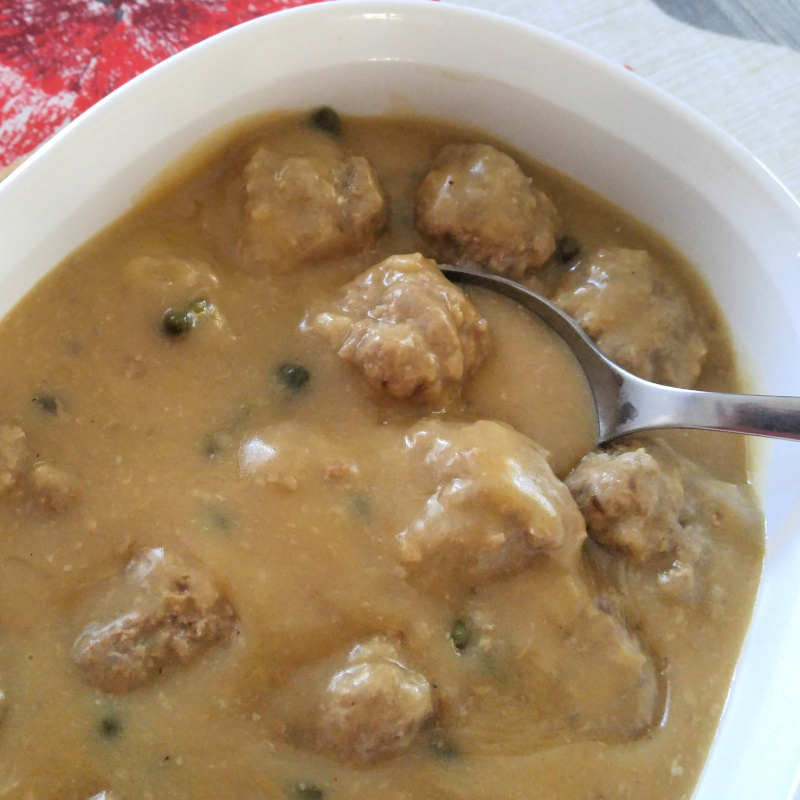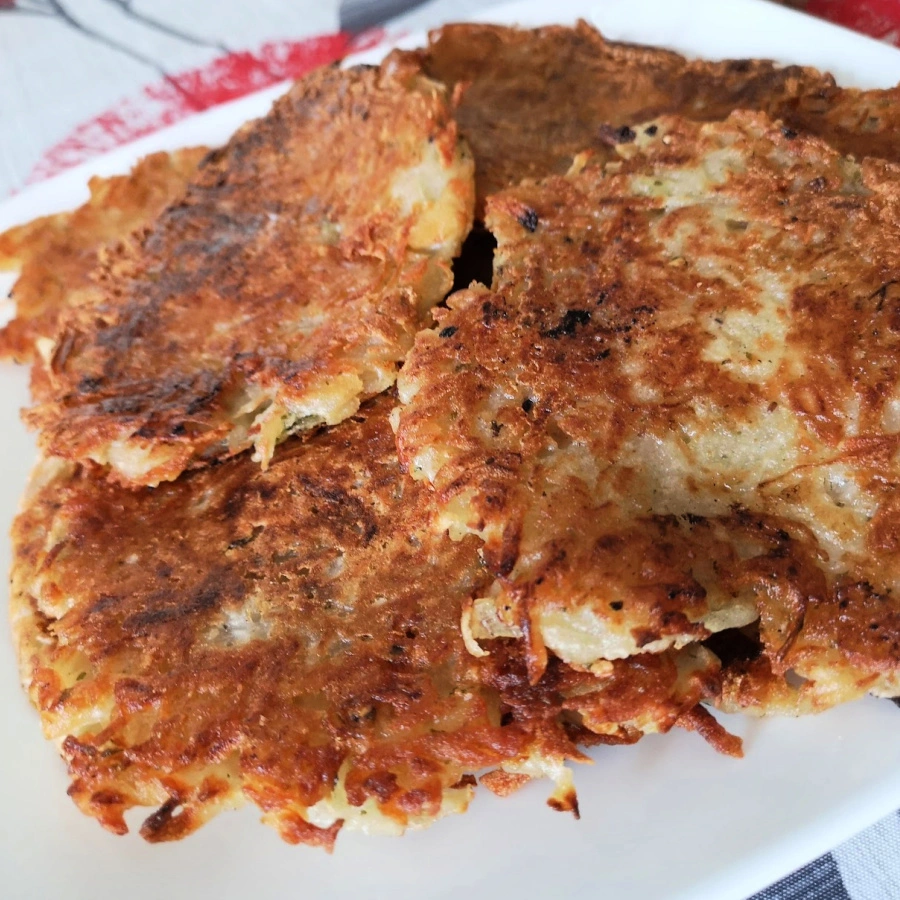- Home
- German Food Guide
- German Apple Strudel Recipe
German Apple Strudel Recipe: Easy Guide to Apfelstrudel
By: Eran Fulson / Writer, Traveler, Explorer of Good Food & Historic Streets / For 15+ years, I’ve lived in Canada and Wales, road-tripped across North America, and trekked through Europe’s mountains, cities, and coastlines. Now, I help travelers uncover hidden gems and culture-rich destinations in Germany with firsthand insights and practical tips.
A German apple strudel recipe is one of those generational foodie hand-me-downs that works for any season. I've had it in my head for years that anything pastry-related required a masters degree in patience. While I'm still waiting for patience, an easy apple strudel recipe can wait no longer.
On this page:
Apple strudel, known as Apfelstrudel in German, is a quintessential dessert that has become synonymous with Central European cuisine. This pastry masterpiece consists of a delicate, flaky crust enveloping a generous filling of spiced apples, often complemented by raisins and nuts.
The term "strudel" translates to "whirlpool" in German, aptly describing the swirling layers of pastry that characterize this dessert.
While apple is the most common filling, strudel can be made with various fruits or even savory ingredients. The pastry's versatility has contributed to its enduring popularity across Germany, Austria, and beyond.
What sets strudel apart from other apple desserts is its distinctive texture - a perfect harmony between the crisp, buttery exterior and the soft, flavorful filling within.
The History of Apfelstrudel
The story of apple strudel is a testament to the rich culinary heritage of Central Europe. While often associated with German cuisine, the strudel origins can be traced back to the Habsburg Empire, with the oldest known strudel recipe dating to 1697 in Vienna, Austria.
Interestingly, the strudel's creation was influenced by Turkish baklava, a legacy of the Ottoman Empire's presence in Eastern Europe. This cultural exchange resulted in the development of the thin, layered pastry technique that defines strudel.
As the Habsburg Empire expanded, so did the popularity of strudel, quickly becoming a staple in what is now Germany, Hungary, and other neighboring countries.

In Germany, particularly in Bavaria, apple strudel gained immense popularity and became deeply ingrained in the local culinary tradition.
German bakers added their own touch to the recipe, often incorporating ingredients like rum-soaked raisins, adding a distinctive flavor profile to the German version of apple strudel.
The dessert's popularity soared in the 18th and 19th centuries, becoming a symbol of refined Viennese and German baking.
Today, Apfelstrudel remains a beloved treat, found in bakeries, cafes, and homes across Germany and around the world, testament to its enduring appeal and the skill of German bakers in preserving this culinary heritage.
Traditional vs. Modern Strudel-Making Techniques
The art of strudel-making has evolved significantly over the centuries, with both traditional and modern techniques offering unique advantages.
Traditional Strudel-Making:

The traditional method of making strudel is a true culinary art form, requiring skill, patience, and often a large workspace. Here's a glimpse into the traditional process:
- Dough Preparation: The dough is made with high-gluten flour, water, oil, and salt. It's kneaded vigorously to develop the gluten, then rested to allow the dough to relax.
- Stretching the Dough: This is the most crucial and impressive step. The dough is stretched by hand over a large surface, often a kitchen table covered with a cloth. Using a delicate touch, the baker stretches the dough until it's so thin that, as the saying goes, you could read a newspaper through it. This ultra-thin dough is the secret to the many delicate, crispy layers in a traditional strudel.
- Filling and Rolling: Once stretched, the dough is brushed with melted butter, sprinkled with breadcrumbs (to absorb excess moisture from the filling), and then the apple filling is spread over one end. The strudel is then carefully rolled using the table cloth to assist in the process.
Modern Strudel-Making Techniques:

While the traditional method produces exceptional results, it's time-consuming and requires considerable skill. Modern techniques have made strudel more accessible to home bakers:
- Using Phyllo Dough: Many modern recipes use store-bought phyllo dough. Multiple layers of phyllo are brushed with butter to mimic the many layers of traditional strudel dough.
- Puff Pastry Method: Another popular modern adaptation is using puff pastry. While this doesn't produce the same texture as traditional strudel, it creates a deliciously flaky pastry that's much easier to work with.
- Food Processor Dough: Some modern recipes create a dough in the food processor that, while not as thin as traditional strudel dough, is easier to handle and still produces good results.
- Ready-Made Strudel Dough: In Germany and Austria, it's possible to buy ready-made fresh strudel dough, which is thinner than phyllo and designed specifically for making strudel.
While purists might argue that only the traditional method produces "true" strudel, modern techniques have helped keep this classic dessert alive in home kitchens. Whether traditional or modern, the goal remains the same: to create a delicious pastry with a flaky exterior and a flavorful filling that honors the rich tradition of Apfelstrudel.
Variations on the Classic Apple Strudel
While traditional Apfelstrudel holds a special place in German cuisine, creative bakers have developed numerous variations that pay homage to the classic while offering unique flavors. Here's an expanded look at some popular variations:
Bavarian Apple Strudel (Bayerischer Apfelstrudel): This regional specialty often includes a layer of sweetened cream cheese or quark (a type of fresh cheese popular in Germany) in addition to the apple filling. The cream cheese adds richness and a subtle tanginess that complements the apples beautifully.
Viennese Apple Strudel (Wiener Apfelstrudel): The Austrian version typically uses breadcrumbs toasted in butter as part of the filling. This not only absorbs excess moisture from the apples but also adds a nutty flavor and interesting texture.
Apple Cinnamon Strudel: This variation amplifies the warm, comforting flavors associated with apple pie. The filling is generously spiced with cinnamon and sometimes includes other warming spices like nutmeg or allspice.
Apple Walnut Strudel: Adding chopped walnuts to the filling provides a delightful crunch and nutty flavor that pairs wonderfully with apples. This version often includes a drizzle of caramel sauce for added indulgence.
Mini Apple Strudels: These individual-sized strudels are perfect for parties or cafes. They're often made by cutting the filled pastry into portions before baking, resulting in cute, portable strudel bites.
Whole Wheat Apple Strudel: For a healthier twist, some bakers use whole wheat flour in the dough. This adds a nutty flavor and boosts the fiber content of the dessert.
Caramel Apple Strudel: This indulgent variation includes a layer of caramel in the filling or a caramel sauce drizzled over the baked strudel.
Apple-Berry Strudel: Adding berries like raspberries or blackberries to the apple filling creates a delightful sweet-tart flavor combination.
Savory Apple Strudel: Some creative cooks have experimented with savory versions, incorporating ingredients like sharp cheddar cheese or bacon with the apples for a unique twist on the classic.
Gluten-Free Apple Strudel: To cater to dietary restrictions, gluten-free versions using alternative flours or gluten-free puff pastry have become increasingly popular.
These variations demonstrate the versatility of strudel and how it has been adapted to suit different tastes and dietary needs while still honoring the essence of this beloved German pastry.
 Would you try a savory strudel? Credit @nadejdasereda
Would you try a savory strudel? Credit @nadejdaseredaApple Strudel Serving Suggestions
The art of serving Apfelstrudel is almost as important as making it. Here are expanded serving suggestions to help you present and enjoy your strudel in true German style:
Classic Dessert Presentation: Serve warm slices of strudel dusted with powdered sugar. Accompany with a scoop of vanilla ice cream (Vanilleeis) or a dollop of lightly sweetened whipped cream (Schlagsahne). The contrast of warm strudel and cold cream or ice cream is quintessentially German.
Viennese Café Style: In the tradition of Viennese coffee houses, serve a slice of strudel alongside a small glass of water and a cup of strong coffee, preferably an espresso or Viennese Melange (similar to a cappuccino).
Breakfast or Brunch: Germans sometimes enjoy sweet pastries for breakfast. Serve a slice of strudel with a café au lait or milchkaffee (coffee with hot milk) for an indulgent start to your day.
Afternoon "Kaffee und Kuchen": This German tradition of coffee and cake in the afternoon is perfect for serving strudel. Pair with a pot of coffee or selection of teas.
Holiday Dessert: Apple strudel makes for a fantastic addition to holiday dessert spreads. For Christmas, serve alongside other traditional German sweets like Lebkuchen or Stollen.
With Vanilla Sauce: For an authentic German experience, serve your strudel with a warm vanilla sauce (Vanillesoße). This creamy sauce complements the apple filling perfectly.
Savory Accompaniment: In some regions, apple strudel is served with a slice of sharp cheese, similar to the American tradition of cheese with apple pie.
Wine Pairing: For an adult dessert, pair your strudel with a sweet German wine like an Eiswein or a late-harvest Riesling.
Fruit Compote: Serve with a side of fruit compote, particularly if made with complementary fruits like pears or berries.
Deconstructed Strudel: For a modern trendy presentation, deconstruct the elements—serve a slice of strudel with a quenelle of vanilla ice cream, a drizzle of caramel sauce, and a sprinkle of toasted almonds.
Remember, presentation is key. Serve on a beautiful plate or traditional German stoneware to enhance the experience and transport your guests to a cozy German café.
 Nothing quite like Oma's vanilla sauce ;-)
Nothing quite like Oma's vanilla sauce ;-)Apple Strudel FAQ
What is German apple strudel made of?
What is German apple strudel made of?
German apple strudel, or Apfelstrudel, consists of a delicate, flaky pastry jacket filled with a mixture of tart, crisp apples (such as Winesap or Granny Smith), sugar, cinnamon, and breadcrumbs.
The filling often includes raisins and sliced almonds for added texture and flavor. The pastry is traditionally made from a soft, elastic dough that's hand-stretched until it's paper-thin, allowing you to read a newspaper through it.
However, many modern recipes use store-bought phyllo or puff pastry for convenience. The strudel is rolled, brushed with melted butter, and baked until golden brown and crispy.
What's the difference between a strudel and a streusel?
What's the difference between a strudel and a streusel?
While their names sound similar, strudel and streusel are quite different. Strudel refers to a type of pastry where thin sheets of dough are wrapped around a filling, creating a rolled, layered dessert.
On the other hand, streusel is a crumbly topping made from a mixture of flour, butter, and sugar, often sprinkled over pies, cakes, and other baked goods.
The confusion often arises because both can be used in apple desserts, but they are distinct in texture and preparation.
Should apple strudel be served hot or cold?
Should apple strudel be served hot or cold?
Apple strudel can be enjoyed both warm and cold, but many prefer it slightly warm for the best flavor and texture experience. When served warm, the pastry remains crisp, and the apple filling is comfortingly soft.
To serve, reheat the strudel in a 300°F (150°C) oven for about 10-15 minutes to crisp up the pastry and warm the filling. Once heated, dust it with powdered sugar and serve with a dollop of whipped cream, a scoop of vanilla ice cream, or a drizzle of vanilla sauce (Vanillesoße) for an authentic German touch.
However, cold strudel can be equally delicious, especially on a warm day or as a quick breakfast treat with coffee.
How long can apple strudel last in the fridge?
How long can apple strudel last in the fridge?
When stored properly, apple strudel can last in the refrigerator for up to 2 days.
To maintain its quality, allow the strudel to cool completely at room temperature before storing. Wrap it tightly in plastic wrap or aluminum foil to prevent it from drying out or absorbing other flavors from the fridge.
When you're ready to eat it, you can enjoy it cold or reheat it in the oven until it's crisp and hot. For longer storage, you can freeze apple strudel for up to 3 months. Wrap it well in freezer-safe packaging, and when you're ready to eat, thaw it overnight in the refrigerator before reheating.
Is apple strudel good for you?
Is apple strudel good for you?
While apple strudel is a delicious treat, it's not typically considered a health food due to its high sugar and fat content from the butter-enriched pastry.
However, it does offer some nutritional benefits. The apple filling provides dietary fiber, vitamins, and antioxidants. Some recipes include nuts like almonds, which add healthy fats and protein.
To make a healthier version, you could use whole wheat flour in the dough, reduce the sugar content, and increase the proportion of apples to pastry. Remember, enjoying traditional foods like apple strudel in moderation can be part of a balanced diet, especially when it's homemade with high-quality ingredients.
The Process:
Now, time to make some Apple Strudel
German Apple Strudel Recipe
This German Apple Strudel recipe is quick, easy, and delicious. Made with only a few simple ingredients, you'll have a cafe-ready dessert without all the traditional labor. Is using puff pastry cutting corners? Maybe, but it still tastes amazing!
Prep Time15 minutes |
Cook Time35 minutes |
Total Time50 minutes |
Servings:
Makes 8 servings
Ingredients:
- 1 pound (453g) apples, peeled, cored, and thinly sliced
- 2 tablespoons (26g) granulated sugar
- 1 tablespoon (8g) all-purpose flour
- ½ pound (227g) frozen butter puff pastry, thawed
- 1 large egg
- 1 tablespoon (15ml) milk
- pinch of salt
- (optional) cinnamon / mixed spice
Instructions:
- Preheat your oven to 375°F (190°C) and line a baking sheet with parchment paper (so cleanup doesn't turn into a nightmare).
- In a big bowl, get the sliced apples, spices (if using), salt, sugar, and flour all involved together. Yes, it is that simple—don't overthink it.
- On a floured surface, roll out the thawed puff pastry into something that resembles a rectangle, ideally about 12x16 inches.
- Spread the apple mixture evenly across the bottom third of the pastry, leaving a 1-inch border around the edges so things don't get messy.
- Fold in the short sides of the dough, then carefully roll up the strudel from the long side.
- Place your rolled-up masterpiece seam-side down on the prepared baking sheet.
- In a small bowl, whisk up an egg, mix with milk, and brush the mixture all over the strudel.
- Grab a sharp knife and make a few diagonal slashes across the top, about 1/4 inch deep. This lets the steam out, or else you'll have a soggy letdown.
- Bake for 35-40 minutes, or until the pastry is golden and crispy—like something you'd want to eat immediately but shouldn't. Because it's hot.
- Let it cool down a little (if you can resist), dust it with powdered sugar (if using), and serve with a dollop of whipped cream, vanilla ice cream, or a drizzle of vanilla sauce if you're feeling particularly swank.
- Enjoy your almost authentic German treat!
Notes/Hints:
- Apple Selection: The choice of apples can make or break your strudel. Tart, firm apples like Granny Smith, Braeburn, or Boskoop are ideal as they hold their shape during baking and provide a nice contrast to the sweet pastry. Mix different varieties for complex flavor.
- Proper Apple Preparation: Slice the apples thinly and evenly to ensure consistent cooking. Toss them with lemon juice to prevent browning and add a hint of brightness to the filling.
- Balancing Moisture: Too much moisture can lead to a soggy strudel. Use breadcrumbs or ground nuts in the filling to absorb excess juice from the apples. If using raisins, soak them in rum or apple juice, but drain well before adding to the filling.
- Layering Technique: When using phyllo pastry, brush each layer lightly with melted butter. This creates distinct, flaky layers and adds rich flavor.
- Rolling and Sealing: Roll the strudel tightly to prevent gaps, but be careful not to tear the dough. Pinch the edges firmly to seal and prevent filling from leaking during baking.
- Egg Wash Application: Apply egg wash evenly for a golden, shiny crust. For extra crunch, sprinkle with coarse sugar before baking.
- Baking Environment: Use a preheated oven and bake on the middle rack for even cooking. A pizza stone can help achieve a crispy bottom crust.
- Resting Period: Allow the baked strudel to rest for 15-20 minutes before slicing. This helps set the filling and makes for cleaner slices.
- Serving Temperature: Strudel is best served warm, not hot. Reheating in a 300°F (150°C) oven for 10-15 minutes can restore crispness.
- Complementary Flavors: Enhance your strudel with complementary spices like cinnamon, nutmeg, or cardamom. A touch of vanilla extract in the filling can add depth.
* * * * *
Unless otherwise noted recipe, images and content © Tour My Germany | tourmygermany.com
German Apple Strudel Recipe: Easy Guide to Apfelstrudel
By Eran Fulson
Experience the taste of Bavaria with our German Apple Strudel Recipe. Learn traditional techniques, serving suggestions, and delicious variations.
Ingredients: apples, sugar, flour, puff pastry, egg, milk salt
For the full recipe, scroll up ...












